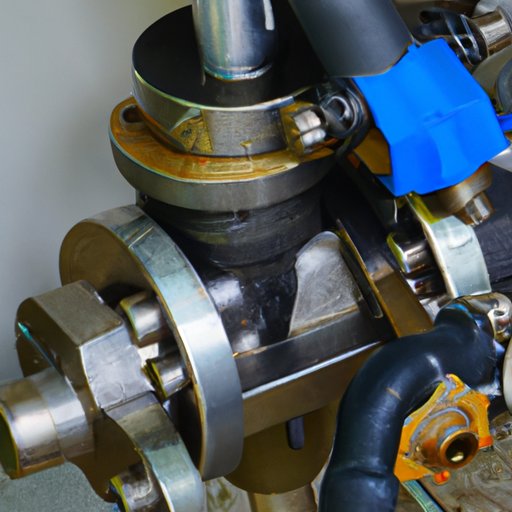Introduction
When you have a mechanical pump system, it is essential that all components work together to achieve optimal functionality. One vital component in this system is the pump flange. A pump flange is a heavy metal ring located at the end of a pump’s discharge nozzle. It is crucial that a pump flange fits correctly to prevent leaks, damage, or even accidents that can lead to significant losses. Improper pump flange fit can cause frustration, increased costs, and dangerous situations. In this article, we will discuss the importance of proper pump flange fit and how to achieve it.
Importance of Proper Pump Flange Fit
A poor pump flange fit can create significant problems for both the pump and the system. Inadequate sealing can cause leakage, which is both messy and dangerous. Leaks can damage the surrounding environment, leading to the loss of product and even harm to personnel. Furthermore, leaks can cause air and gas to enter the pumping system, affecting performance and efficiency. Other issues caused by poor pump flange fit are vibration, noise, temperature rises, and wear on components. It is crucial to ensure the pump flange fits correctly to prevent such problems.
Steps Required to Achieve a Proper Pump Flange Fit
To achieve proper pump flange fit, several steps must be followed. The first step is to measure accurately the dimensions of the pump’s flange. It is essential to check the dimensions of the pump flange and compare them to the dimensions of the flange on the connected pipeline. After taking the measurements, the next step is to ensure the gaskets selected are appropriate for the pump’s application. It is essential to select the right gasket material and thickness to provide proper sealing and prevent leakage. The third step is tightening the bolts to the correct torque. Over-tightening the bolts can cause damage, while under tightening can cause leakage.
Measuring Pump Flange Dimensions
To measure the dimensions of the pump’s flange, the following steps should be taken:
1. Determine the diameter of the pipe and the flange face.
2. Measure the bolt circle diameter.
3. Check the number of bolts required and their size.
4. Check the distance between the bolt holes.
5. Measure the thickness of the flange face.
Taking accurate measurements is essential to prevent frustration, extra cost, and dangerous situations that can be caused by inaccurate pump flange measurements. When the flange measurements are accurate, parts can be ordered and machined to precise specifications, ensuring proper pump flange fit.
Using Gaskets for Proper Pump Flange Fit
Gaskets play a vital role in creating proper sealing and preventing leaks in a pump flange system. There are several types of gaskets available, including metal, non-metallic, and composite gaskets. The selection of gasket materials and thickness is essential to creating a proper pump flange fit. Factors to consider when selecting gaskets are the chemical compatibility with the fluid transferred through the pump, temperature, and pressure requirements. Choosing the right gasket material and thickness ensures proper sealing while preventing over-compression and the consequent damage to the flange faces.
Tightening Bolts for Pump Flange Fit
Tightening bolts correctly is crucial to achieving proper pump flange fit and avoiding leakage, vibration, and other potential problems. The use of a torque wrench is essential to ensure the correct torque is applied to the bolts. Over-tightening the bolts can lead to flange distortion and damage, while under-tightening can cause leaks. Tightening bolts should be done gradually and evenly in a specific pattern to prevent overloading on one side of the flange. Using a torque wrench helps avoid problems by ensuring bolts are tightened to the manufacturer’s recommended torque specification.
Troubleshooting Improper Pump Flange Fit
Despite taking all necessary precautions, problems can still occur with the pump flange system. When facing common problems resulting from improper pump flange fit, it is critical to identify the cause and implement appropriate remedies. The following problems may arise: vibration or noise in the system, leakage at the flange points, and temperature rises. Solutions for addressing each problem may include the selection and replacement of appropriate gaskets and tightening or loosening bolts to achieve the correct torque.
Best Practices for Maintaining Pump Flange Fit
Preventative maintenance is the best way to ensure proper pump flange fit throughout the lifespan of the pump. The following maintenance practices should be followed: regular inspection of flanges and gaskets for wear and damage, tightening loose bolts, and cleaning the flanges and the bolts to prevent corrosion. It is important to take care of the pump’s flange system to ensure optimal performance, prevent leaks, and avoid costly repairs or downtime.
Conclusion
In summary, the pump’s flange is an essential component of a pump system, and proper pump flange fit is crucial to avoiding problems such as leakage, vibration, and temperature rise. It is important to follow best practices to achieve and maintain proper pump flange fit, including accurate measurement, appropriate selection, and use of gaskets, gradually and evenly tightening bolts to the recommended torque specification, and regularly inspecting, cleaning, and maintaining flanges and bolts. By following these steps, your pump system will operate efficiently, with minimal downtime, and optimize performance.
(Note: Is this article not meeting your expectations? Do you have knowledge or insights to share? Unlock new opportunities and expand your reach by joining our authors team. Click Registration to join us and share your expertise with our readers.)
